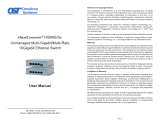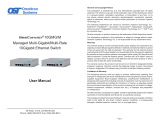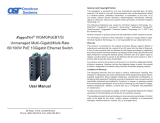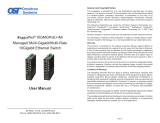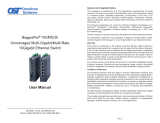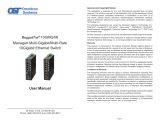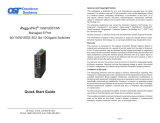Page is loading ...

OmniConverter® 10GMGPoEBT/M
Managed Multi-Gigabit/Multi-Rate
60/100W PoE 10Gigabit Ethernet Switch
User Manual
38 Tesla, Irvine, CA 92618 USA
Phone: (949) 250-6510; Fax: (949) 250-6514
General and Copyright Notice
This publication is protected by U.S. and international copyright laws. All rights
reserved. The whole or any part of this publication may not be reproduced, stored
in a retrieval system, translated, transcribed, or transmitted, in any form, or by
any means, manual, electric, electronic, electromagnetic, mechanical, chemical,
optical or otherwise, without prior explicit written permission of Omnitron Systems
Technology, Inc.
The following trademarks are owned by Omnitron Systems Technology, Inc.:
FlexPointTM, FlexSwitchTM, iConverter®, miConverterTM, NetOutlook®, OmniLight®,
OmniConverter®, RuggedNet®, Omnitron Systems Technology, Inc.TM, OSTTM and
the Omnitron logo.
All other company or product names may be trademarks of their respective owners.
The information contained in this publication is subject to change without notice.
Omnitron Systems Technology, Inc. is not responsible for any inadvertent errors.
Warranty
This network product and the included AC/DC power adapter are warranted to the
original purchaser (Buyer) against defects in material and workmanship for a period
of two (2) years from the date of shipment. The warranty for the network product
(excluding the AC/DC power adapter) can be extended to ve (5) years by registering
the product at www.omnitron-systems.com/support within ninety (90) days from the
date of shipment. During the warranty period, Omnitron will, at its option, repair or
replace a product which is proven to be defective with the same product or with a
product with at least the same functionality.
For warranty service, the product must be sent to an Omnitron designated facility,
at Buyer’s expense. Omnitron will pay the shipping charge to return the product
to Buyer’s designated US address using Omnitron’s standard shipping method.
Limitation of Warranty
The foregoing warranty shall not apply to product malfunctions resulting from
improper or inadequate use and/or maintenance of the equipment by Buyer, Buyer-
supplied equipment, Buyer-supplied interfacing, unauthorized modications or
tampering with equipment (including removal of equipment cover by personnel not
specically authorized and certied by Omnitron), or misuse, or operating outside
the environmental specication of the product (including but not limited to voltage,
ambient temperature, radiation, unusual dust, etc.), or improper site preparation
or maintenance.
No other warranty is expressed or implied. Omnitron specically disclaims the implied
warranties of merchantability and tness for any particular purpose.
The remedies provided herein are the Buyer’s sole and exclusive remedies. Omnitron
shall not be liable for any direct, indirect, special, incidental, or consequential
damages, whether based on contract, tort, or any legal theory.
Page 2

Environmental Notices
The equipment covered by this manual must be disposed of or recycled in
accordance with the Waste Electrical and Electronic Equipment Directive (WEEE
Directive) of the European Community directive 2012/19/EU on waste electrical and
electronic equipment (WEEE) which, together with the RoHS Directive 2015/863/
EU, for electrical and electronic equipment sold in the EU after July 2019. Such
disposal must follow national legislation for IT and Telecommunication equipment
in accordance with the WEEE directive: (a) Do not dispose waste equipment with
unsorted municipal and household waste. (b) Collect equipment waste separately.
(c) Return equipment using collection method agreed with Omnitron.
The equipment is marked with the WEEE symbol shown to indicate that it
must be collected separately from other types of waste. In case of small items the
symbol may be printed only on the packaging or in the user manual. If you have
questions regarding the correct disposal of equipment go to www.omniton-systems.
com/support or e-mail to Omnitron at [email protected].
Safety Warnings and Cautions
ATTENTION: Observe precautions for handling electrostatic discharge
sensitive devices.
WARNING: Potential damage to equipment and personal injury.
WARNING: Risk of electrical shock.
OmniConverter® 10GMGPoEBT/M
User Manual
Product Overview
The OmniConverter 10GMGPoEBT/M are managed multi-gigabit Ethernet switches
featuring one 1/10G SFP/SFP+ or multi-gigabit/multi-rate RJ-45 uplink port with
two multi-gigabit/multi-rate RJ-45 Power-over-Ethernet and two 10/100/1000 RJ-45
Power-over-Ethernet downlink/access ports.
The mode of operation can be congured using easily accessible DIP-switches or
using Web, Telnet, SSH, SNMPv1/v2c/v3 or Serial Console management interfaces.
These management interfaces provide access to ltering and security options,
such as, broadcast storm prevention, IGMP, IEEE 802.1x, RADIUS, TACACS+ and
Access Control Lists. Email event notication and alarm reporting is provided using
Simple Mail Transfer Protocol.
To access the user manuals for the Web Interface, Command Line Interface and
Hierarchical Command Line Interface, access the OmniConverter 10GMGPoEBT/M
product page.
The 10GMGPoEBT/M supports IEEE 802.3bt (60 and 100W) per user port depending
on the model supports frame sizes up to 10,240 bytes.
Front Panel
The front of the module provides access to the RJ-45 PoE and uplink ports.
RJ-45 PoE and Uplinks Ports
The module has two RJ-45 PoE multi-gigabit/multi-rate ports and two RJ-45 PoE
10/100/1000 ports. The multi-gigabit/multi-rate ports support speeds of 100Mbps,
1Gbps, 2.5Gbps, 5Gbps and 10Gbps.
Models are available with an RJ-45 or SFP/SFP+ uplink port.
The SFP/SFP+ uplink port support SERDES 10GBASE-X and 1000BASE-X ber
transceivers, and 10/100/1000BASE-T,
1000BASE-T, 2.5BASE-T, 5GBASE-T
and
10GBASE-T copper transceivers.
The RJ-45 uplink port is a multi-gigabit/multi-rate supporting speeds of 100Mbps,
1Gbps, 2.5Gbps, 5Gbps and 10Gbps.
Page 3 Page 4

Page 5
Serial Console Port
To congure the module using the serial port, attach a DB-9 serial (RS-232)
equipped computer with terminal emulation software such as Procomm or Putty
to the serial port on the module using a RJ-45 to DB-9 serial cable (not included).
Some computers do not come with DB-9 serial port connectors and may require a
USB-to-serial port adapter.
The port is a standard RS-232 asynchronous serial interface. The serial ports is
congured for 57,600bps, 1 stop, 8 data, parity none. The serial adapter cable
pin-outs are illustrated below.
Reset Button
A reset button is available on the front of the switch to restore the switch to factory
default values. Press and hold the reset button for more than 5 seconds to be able
to restore the switch to factory default values.
Installation Procedure
1) Congure DIP-switches
2) Installing the Module
3) Apply Power
4) Connect Cables
5) Verify Operation
1) Congure DIP-switches
DIP-switches are located on the side of the module. The DIP-switches are used to
congure modes of operation, networking features and PoE reset.
Page 6
The table below provides a description of each DIP-switch position and function.
Switch Position Legend Function
SW1 DOWN Normal Normal Switch Mode is Enabled (factory default)
UP Directed Switch Directed Switch Mode (aka camera mode) is Enabled
SW2 DOWN Off PoE Reset is Disabled (factory default)
UP PoE Reset PoE Reset is Enabled on all ports.
SW3 DOWN On PoE Power is Enabled (factory default)
UP PoE Disabled PoE Power is Disabled
SW4 DOWN Off
PoE Forced Mode
UP On
SW5 DOWN Off
UP On
SW6 DOWN On MAC Learning Enabled (factory default)
UP MAC Learning MAC Learning Disabled
SW7 DOWN Off Pause Disabled (factory default)
UP Pause Pause Enabled
SW8 DOWN L2CP Tunnel L2CP Tunnel (factory default)
UP Discard L2CP Tunnel Discard
SW1: Switch Mode - “Normal/Directed Switch”
The module supports Normal or Directed Switch Mode.
The modes are described with MAC learning enabled. When MAC learning is
disabled, unicast packets are forwarded to all ports.
Switch Mode
When SW1 is in the factory default DOWN “Normal” position, the module operates
as a standard layer 2 switch. Data ow will follow MAC address mapping.
Directed Switch Mode (AKA Camera Mode)
When SW1 is in the UP “Directed Switch” position, the module is congured for
Directed Switch Mode. In this mode of operation, trafc from all the RJ-45 user
ports is only forwarded to the uplink port F1, preventing the broadcast trafc from
ooding other network ports.

Page 7
SW2: PSE Reset - “Off/PoE Reset”
The module can be congured to disable (reset) the PoE output power for 5 seconds
after a loss of receive link on the uplink port. PoE output power will be disabled on
all ports. This feature is typically used to allow a PD to re-initialize after a failure
on the incoming uplink.
When this DIP-switch is in the DOWN “Off” position (factory default), PoE output
power does not reset on a loss of receive link on the uplink port. When this DIP-
switch is in the UP “PoE Reset” position, the module will disable PoE output power
on all PoE ports for 5 seconds following a loss of receive link on any uplink port.
SW3: PoE Power - “On/PoE Disabled)
When this DIP-switch is in the DOWN “On” position (factory default), all the PoE
ports are enabled with PoE PSE functionality. When this DIP-switch is in the UP
“PoE Disabled” position, all the PoE ports are disabled with PoE PSE functionality.
SW4 and SW5: PoE Forced - “Disabled/Enabled”
These DIP-switches congure the PoE ports for normal or forced mode per the
table below.
60 Watt Models
SW4 SW5 Function
DOWN DOWN Normal 802.3bt mode on all ports, classes 0-6, limitation per class negotiation
DOWN UP
Normal 802.3bt mode on ports P1 and P2
(class 0-6, limitation per class negotiation)
Forced 802.3bt mode, on ports P3 and P4
(class 0-8, limited to 60W independent of class negotiation)
UP DOWN
Forced 802.3bt mode on ports P1 and P2
(class 0-8, limited to 60W independent of class negotiation)
Normal 802.3bt mode on ports P3 and P4
(class 0-6, limitation per class negotiation)
UP UP Forced 802.3bt mode on all port,
(class 0-8, limited to 60W independent of class negotiation)
100 Watt Models
SW4 SW5 Function
DOWN DOWN Normal 802.3bt mode on all port, classes 0-8, limitation per class negotiation
DOWN UP
Normal 802.3bt mode on ports P1 and P2
(class 0-8, limitation per class negotiation)
Forced 802.3bt mode, on ports P3 and P4
(class 0-8, limited to 100W independent of class negotiation)
UP DOWN
Forced 802.3bt mode on ports P1 and P2
(class 0-8, limited to 100W independent of class negotiation)
Normal 802.3bt mode on ports P3 and P4
(class 0-8, limitation per class negotiation)
UP UP Forced 802.3bt mode on all ports,
(class 0-8, limited to 100W independent of class negotiation)
SW6: MAC Learning - “On/MAC Learning”
When this DIP-switch is in the DOWN “On” position (factory default), all ports on
the module will learn the source MAC address of each received packet and store
Page 8
the address so packets destined for the stored addresses can be forwarded to the
appropriate port on the module. When the DIP-switch is in the UP “MAC Learning”
position, learning is turned off and all received unicast packets are forwarded to
all ports.
SW7: Pause - “Off/Pause”
Setting the DIP-switch to the DOWN “Off” position (factory default) congures
the module to advertise no Pause capability on all ports. Setting this DIP-switch
to the UP “Pause” position congures the module to advertise Symmetrical and
Asymmetrical Pause capability to all ports.
SW8: L2CP - “L2CP Tunnel/Discard”
When this DIP-switch is in the DOWN “L2CP Tunnel” position (factory default), all
L2CP frames will be tunneled through the module. When this DIP-switch is in the
UP “Discard” position, all L2CP frames will be discarded with the exception of the
frames listed below.
Multicast
Destination Address Name SW8 L2CP
DOWN or UP
01-80-C2-00-00-00 Bridge Group Address Tunnel
01-80-C2-00-00-01 IEEE Std 802.3 Full Duplex PAUSE Based on PAUSE
01-80-C2-00-00-0B Reserved for future standardization Tunnel
01-80-C2-00-00-0C Reserved for future standardization Tunnel
01-80-C2-00-00-0D Provider Bridge GVRP Address Tunnel
01-80-C2-00-00-0F Reserved for future standardization Tunnel
01-80-C2-00-00-10 All Bridges Tunnel
01-80-C2-00-00-2X GARP Tunnel
01-80-C2-00-00-3X 802.1ag CFM Tunnel
If SW7 is in the DOWN “Off” position, all PAUSE frames are TUNNELED. If SW7
is in the UP “Pause” position, the module is participating in the PAUSE function.
2) Installing the Module
Wall Mounting
The wall mounting height of the module should be less than or equal to 2 meters
(6.6 feet) from the oor. Use the four mounting holes on the module to secure the
module to the wall. The module can accommodate #6 screws (not included).
Installation of the module should be such that the air ow in the front, back, side
and top vents of the switch are not compromised or restricted.
The accessory cables should have their own strain relief and do not pull down on
the module.
Rack Mounting
The module can be rack mounted using the optional Rack Mount Shelf (8260-0).
Refer to the Rack Mount Shelf user manual (040-08260-001x) for the proper
installation guidelines. Follow the same guidelines above when rack mounting
the module.

Page 9
DIN-Rail Mounting
The module can be DIN-rail mounted using the optional DIN-Rail Mounting Clips
(8251-1). Refer to the DIN-Rail Mounting Clips user manual (040-08251-001x) for
the proper installation guidelines.
3) Apply Power
AC Power
Secure the ground wire to the ground screw. See the gure below for the location
of the grounding screws.
Route the power cord through the provided strain relief for additional support and
connect the DIN connector at the end of the wire on the AC/DC adapter to the DIN
connector on the module. Connect the AC/DC adapter to the AC outlet. Conrm
that the module has powered up properly by checking the Power LED located on
the front of the switch.
Make sure to disconnect the power and ground cables before removing the module.
NEVER ATTEMPT TO OPEN THE CHASSIS OR
SERVICE THE POWER SUPPLY. OPENING THE
CHASSIS MAY CAUSE SERIOUS INJURYOR DEATH.
THERE ARE NO USER REPLACEABLE OR
SERVICEABLE PARTS IN THIS UNIT.
WARNING!!!
DC Power
This module is intended for installation in restricted access areas. (“Les matériels
sont destinés à être installés dans des EMPLACEMENTS À ACCÈS RESTREINT”).
A restricted access area can be accessed only through the use of a special key, or
other means of security.
The over current protection for connection with centralized DC shall be provided in
the building installation, and shall be a UL listed circuit breaker rated 20 Amps, and
installed per the National Electrical Code, ANSI/NFPA-70.
The 60 watt 10GMGPoEBT/M requires +46 to +57VDC (4.52A @ 56VDC max
rated power) and the 100 watt 10GMGPoEBT/Sx requires +46 to +57VDC (7.4A
@ 56VDC max rated power).
Appropriate overloading protection should be provided on the DC power source
outlets utilized.
Page 10
WARNING: OnlyaDC power source that complies with
safety extra low voltage (SELV) requirements can be
connected to the DC-input power supply.
WARNING REGARDING EARTHING GROUND:
o
o
o
o
This equipment shall be connected to the DC supply
system earthing electrode conductor or to a bonding
jumper from an earthing terminal bar or bus to which the
DC supply system earthing electrode is connected.
This equipment shall be located in the same immediate
area (such as adjacent cabinets) as any other equipment
that has a connection between the earthed conductor of
the same DC supply circuit and the earthing conductor,
and also the point of earthing of the DC system. The DC
system shall not be earthed elsewhere.
The DC supply source is to be located within the same
premises as this equipment.
There shall be no switching or disconnecting devices in
the earthed circuit conductor between the DC source and
the earthing electrode conductor.
Locate the DC circuit breaker of the external power source, and switch the circuit
breaker to the OFF position.
Prepare a power cable using a three conductor insulated wire (not supplied) with
12AWG to 14AWG thickness. Cut the power cable to the length required.
Strip approximately 3/8 of an inch of insulation from the power cable wires.
Connect the ground wire to the grounding screws on the back of the module.
Connect the power cables to the module by fastening the stripped ends to the DC
power connector.
WARNING: The positive lead of the power source must be connected to the
“+” terminal on the module and the negative lead of the power source to the
“-“ terminal on the module as shown above.

Page 11 Page 12
WARNING: Note the wire colors used in making the positive, negative and
ground connections. Use the same color assignment for the connection at
the circuit breaker.
Connect the power wires to the circuit breaker and switch the circuit breaker ON.
If any module are installed, the Power LED will indicate the presence of power.
During the installation, ensure that the ground potentials are maintained throughout
the system connections. This includes but not limited to the power source ground
and any shielded cabling grounds.
NEVER ATTEMPT TO OPEN THE CHASSIS OR
SERVICE THE POWER SUPPLY. OPENING THE
CHASSIS MAY CAUSE SERIOUS INJURYOR DEATH.
THERE ARE NO USER REPLACEABLE OR
SERVICEABLE PARTS IN THIS UNIT.
WARNING!!!
Make sure to disconnect the power and ground cables before removing the
equipment.
4) Connect Cables
a. Insert the appropriate ber or copper transceiver into the SFP receptacle on
the front of the module (see the SFP Data Sheet 091-17000-001 for supported
Gigabit transceivers or 091-17400-001 for supported 10G transceivers).
NOTE: The release latch of the SFP ber transceiver must be in the closed
(up) position before insertion.
b. Connect the appropriate cable type depending on the installed SFP/SFP+
transceiver.
For ber transceivers,it is important to ensure that the transmit (TX) is attached
to the receive side of the transceiver at the other end and the receive (RX)
is attached to the transmit side. When using single-ber (SF) models, the
TX wavelength must match the RX wavelength at the other end and the RX
wavelength must match the TX wavelength at the other end.
c. Connect the RJ-45 ports using an Ethernet Category 5 or better cable to the
external Ethernet device.
Description
15W
IEEE 802.3af
PoE
30W
IEEE 802.3at
PoE+
60W
IEEE 802.3.bt
PoE (Type 3)
100W
IEEE 802.3bt
PoE (Type 4)
Power Supply Voltage
Range 46.0 to 57.0 VDC 51.0 to 57.0 VDC 51.0 to 57.0 VDC 53.0 to 57.0 VDC
Voltage Range at
PSE port Output 44.0 to 56.0 VDC 50.0 to 56.0 VDC 50.0 to 56.0 VDC 52.0 to 56.0 VDC
Maximum Power from
PoE/PSE port 15.4 watts 30 watts 60 watts 100 watts
Minimum Voltage at
PoE/PD port input* 37.0 VDC 42.5 VDC 42.5 VDC 41.1 VDC
Minimum Power at
PoE/PD port* 12.95 watts 25.5 watts 51 watts 71 watts
* at 100 meters using Cat5
4) Verify Operation
Verify the module is operational by viewing the LED indicators.
Power LED Indicators
Legend Indicator Description
Pwr
OFF Unit not powered
Green - ON Unit powered
Green - Blinking at 1Hz Ready for factory reset (reset button has been pushed)
Uplink LED Indicators (SFP/SFP+ or RJ-45)
Legend Indicator Description
Link
OFF Port not linked
Green - ON Port linked at the speed indicated by the Rate LED
Green - Blinking at 10Hz Port is linked and transmitting or receiving data
Rate
OFF Port not linked
Green - single blink Port linked at 10M, 100M or 1G
Green - two blinks Port linked at 2.5G
Green - three blinks Port linked at 5G
Green - four blinks Port linked at 10G
Multi-Gigabit/Multi-Rate RJ-45 Port LED Indicators
Legend Indicator Description
Link
OFF Port not linked
Green - ON Port linked at the speed indicated by the Rate LED
Green - Blinking at 10Hz Port is linked and transmitting or receiving data
Rate
OFF Port not linked
Green - single blink Port linked at 100M or 1G
Green - two blinks Port linked at 2.5G
Green - three blinks Port linked at 5G
Green - four blinks Port linked at 10G
PSE (Status)
OFF Port PSE inactive or disabled
Amber - Solid Failed PoE negotiation
Amber - Blinking at 1Hz Cannot provide requested current (power)
Green - single blink Powered by 802.3bt PoE (4 - 19W, Classes 0 - 3)
Green - two blinks Powered by 802.3bt PoE+ (30W, Class 4)
Green - three blinks Powered by 802.3bt 4PPoE (45W, 60W), class 5 & 6
Green - four blinks Powered by 802.3bt 4PPoE (75W, 100W), class 7 & 8

Page 13 Page 14
10/100/1000 RJ-45 Port LED Indicators
Legend Indicator Description
Link
OFF Port not linked
Green - ON Port linked at the speed indicated by the Rate LED
Green - Blinking at 10Hz Port is linked and transmitting or receiving data
Rate
OFF Port not linked
Green - single blink Port linked at 10M
Green - two blinks Port linked at 100M
Green - three blinks Port linked at 1G
PSE (Status)
OFF Port PSE inactive or disabled
Amber - Solid Failed PoE negotiation
Amber - Blinking at 1Hz Cannot provide requested current (power)
Green - single blink Powered by 802.3bt PoE (4 - 19W, Classes 0 - 3)
Green - two blinks Powered by 802.3bt PoE+ (30W, Class 4)
Green - three blinks Powered by 802.3bt 4PPoE (45W, 60W), class 5 & 6
Green - four blinks Powered by 802.3bt 4PPoE (75W, 100W), class 7 & 8
Specications
Description
OmniConverter® 10GMGPoEBT/M
Managed IEEE 802.3bt 10Gigabit Multi-Gigabit/Multi-Rate Ethernet
Switch
Standard Compliances
IEEE 802.3, 802.3bz,
IEEE 802.3af (15.4 watts max), IEEE 802.3at (30 watts max)
IEEE 802.3bt (60 watts or 100 watts max)
Environmental REACH, RoHS and WEEE
Management
IPv4 and IPv6 address
Web, Telnet, SSH, SNMPv1/v2c/v3
In-Band via Ethernet port, Out-of-band via serial port
PoE Modes IEEE Alternate A (Alt A)
Frame Size Up to 10,240 bytes
Copper:
SFP/SFP+:
Port Types
100/1000BASE-T/2.5GBASE-T/5GBASE-T/10GBASE-T (RJ-45)
10/100/1000BASE-T (RJ-45)
10GBASE-X Fiber Transceivers,
10GBASE-T Copper Transceivers
1000BASE-X Fiber Transceivers,
1000BASE-T Copper Transceivers
10/100/1000BASE-T SGMII Copper Transceivers
100/1000/2.5G/5G/10GBASE-T Multi-rate Copper Transceivers
Copper:
Cable Types
Fiber:
Twisted-pair cable up to 100 meters
10BASE-T: 4-pair UTP Cat 3, 4, 5, 5e, 6, 6A
100BASE-TX: 4-pair UTP Cat 5, 5e, 6, 6A
1G/2.5G: 4-pair UTP Cat 5e, 6, 6A, 7
5G: 4-pair UTP Cat 6, 6A, 7
10G: 4-pair UTP Cat 6A, 7
Multimode: 50/125, 62.5/125µm
Single-mode: 9/125µm
AC Power Requirements
(Models with AC/DC Adapters)
100 - 240VAC/50 - 60Hz
3.5A max at 115VAC
2.5A max at 230VAC
Supplied adapter provides 250W
DC Power Requirements
(Models with DC Terminals)
60 watt Model
+46 to +57VDC;
4.52A @ 56VDC
2 Pin Terminal (isolated)
100 watt Model
+46 to +57VDC;
7.4A @ 56VDC
2 Pin Terminal (isolated)
Dimensions (W x D x H) 6.28” x 5.2” x 1.5” (159.5 mm x 132.1 mm x 38.1 mm)
Weight Module Only: 1.6 lbs. (726 grams)
Module with AC/DC Adapter: 3.7 lbs. (1.68 kg)
Operating Temperature
(See Temperature Derating
Table)
Commercial: 0 to 50°C
Wide: -40 to 60°C (-20°C AC cold start)
Extended: -40 to 75°C (not available for models with
AC/DC power adapter
Storage: -40 to 80°C
Humidity 5 to 95% (non-condensing)
Altitude -100m to 4,000m (operational)
MTBF (hours) Module Only: 235,000
AC/DC Adapter: 100,000
Warranty 5 year product warranty with 24/7/365 free Technical Support and 2
year AC power adapter warranty

Page 15 Page 16
Regulatory
Compliances
(Pending)
Safety: UL 62368-1,
UL 60950-1,
IEC 62368-1,
IEC 60950-1,
EN 62368-1,
EN 60950-1,
CAN/CSA C22.2 No. 62368-1-14,
CAN/CSA C22.2 No. 60950-1,
CE Mark, UKCA
EMC: EN 55032/24 CE Emissions/Immunity,
IEC 61000-6-4 Industrial Emissions,
IEC 61000-6-2 Industrial Immunity
EMI: CISPR 32,
FCC 47 Part 15 Subpart B Class A
EMS: IEC 61000-4-2 ESD: Contact: 6 kV; Air: 8 kV,
IEC 61000-4-3 RS: 80 MHz to 1 GHz: 10 V/m,
IEC 61000-4-4 EFT: Power: 2 kV;
Signal: 1 kV (DC models),
IEC 61000-4-4 EFT: Power: 1 kV;
Signal: 1 kV (AC models),
IEC 61000-4-5 Surge: Power: 2 kV;
Signal: 2 kV (DC models),
IEC 61000-4-5 Surge: Power: 1 kV Line/Line; 2 kV Line/Gnd;
Signal: 2 kV (AC models),
IEC 61000-4-6 CS: Signal: 10 V,
IEC 61000-4-8 (Magnetic Field) 30A/m,
IEC 61000-4-11 (Voltage Dips, interrupts)
IP Rating: IP20 Protection
ACT: TAA, BAA, NDAA
AC/DC Adapter Temperature Derating
Total Available Wattage to RJ-45 Ports
Model Watts Required Watts Required
@ 40°C
Watts Required
@ 50°C
Watts Required
@ 60°C
10GMGPoEBT/M 60W 240 watts 235 watts 170 watts 110 watts
10GMGPoEBT/M 100W 400 watts 235 watts 170 watts 110 watts
The AC/DC Adapter Temperature derating table is not applicable to models with DC Terminal (see
Ordering table for Direct DC power option 9). The DC Terminal models will provide full PoE power over
the operating temperature range of the module as long as the DC input voltage meets the requirements
stated in the specication tables.
Customer Support Information
If you encounter problems while installing this product, contact Omnitron Technical
Support:
Phone: (949) 250-6510
Fax: (949) 250-6514
Address: Omnitron Systems Technology, Inc.
38 Tesla
Irvine, CA 92618, USA
Email: [email protected]
URL: www.omnitron-systems.com
040-09657-001A 11/23
/
